Container spot freight rate index (SHIFEX by Shifl) points to an ongoing decline in spot rates that is set to shift the power marginally away from the carriers, which is good news for US consumers.
Shifl’s data shows that the shipping rate for a 40’ container from China to the US West Coast is set to fall below $5,000 for the first time since the spike caused by the pandemic.
Shipping a 40’ container from China to Los Angeles and Long Beach will now cost, on average about $4,900 in September 2022, which is a 72% decline Y-O-Y from a high of USD17,500 in September 2021.
On the all-water route from China to New York, the year-on-year decline was also significant but less drastic compared to the West Coast, with 40’ container rates set to drop 54% to an average of $8,900 compared to $19,500 in September 2021.
Transit Times to the US is improving slowly
Lines servicing the US trades have been able to improve transit times in the last three months with notable improvements in particular on the route between China and the US West Coast.
Transit times on the Trans-Pacific trade, especially East Coast, have been impacted since the start of the year due to the decision by shippers to reroute shipments to the East Coast to avoid long delays on the West Coast. The significant delays which were built up in the first quarter of 2022 appear to have reduced month-on-month since a peak in April.
The average time it takes to sail from China to New York is now 46 days. While significantly higher than the pre-pandemic average, it’s a notable improvement from the peak of 50 days recorded in April.
Transit times from China to US West Coast ports, by contrast, were down marginally to 32 days, which is down notably from the peak of 50 days recorded in December 2021.
Relatively speaking, the transit time between Los Angeles and China is still twice the time it would take the same vessel to transit the route prior to the pandemic.
Comparing the two routes, ships calling to the US East Coast have been relatively less impacted by the congestion issues that have been felt over the past two years as it is currently taking 1.7 times more time to sail from China to New York time when compared to sailing times pre-pandemic.
Gate Times Steady
Currently, there is a build-up of empty containers in the US, which has put pressure on some ports for space and chassis which are being used as storage facilities.
In a bid to avoid a build-up of empties caused by the imbalance in trade between China and the US, ports like New York and New Jersey have announced the implementation of a quarterly container imbalance fee that will come into effect on September 1. The new charge intends to target ocean carriers who have excess empty containers stored in the port for long periods.
Due to the build-up of empty containers in the terminal, the gate-out times for full import containers have increased. After stabilizing at 5 days in the last three months, the average gate-out time for full import containers in Los Angeles was up in July from 5 days in June to 6 days in July.
In New York, the number of days it takes to ship a container out of the port was steady at 4 days but still up from a low of 3 days in May.
Source: www.shippingandfreightresource.com








































